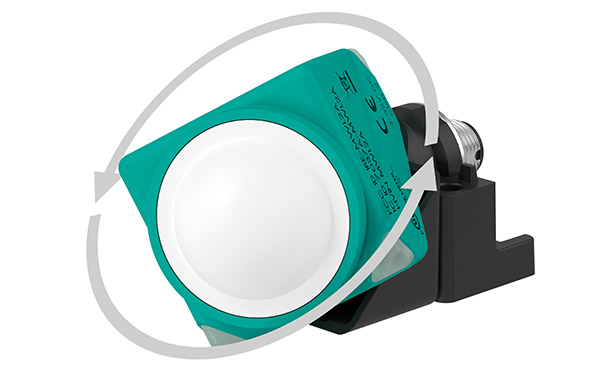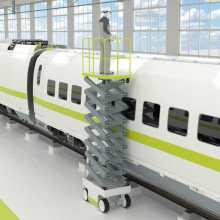Industrial radar sensor with CAN interface
- Details
- Hits: 883
The new radar sensors from Pepperl + Fuchs are extremely compact. Housed in an IP68/69 housing, they are particularly robust. The design also allows maximum flexibility during assembly. The rotatable and pivotable sensor head from Radar sensor can be optimally aligned to the target area in almost any installation situation.

Contents
- How radar sensors work
- Communication and connectivity of the radar sensors
- Radar sensor with three measuring modes
- Technical lecture on the new radar sensor
Industrial radar sensors from Pepperl+Fuchs use electromagnetic waves as a physical principle. Radar waves. These radar waves have special properties that make them ideal for automating applications in which other sensory principles reach their limits: They are not susceptible to interference, propagate at almost the speed of light and are reflected differently well by almost all materials . At the same time, however, they are also able to penetrate most substances to a certain extent.
How radar sensors work

Radar technology (Radio Detection And Ranging) uses an active transmission and reception process Microwave GHz range. The radar sensor sends out an electromagnetic wave, detects its reflection and uses the difference in transit time and frequency to determine the distance and speed to the target object. Since electromagnetic waves propagate at the speed of light, this happens with practically no time delay.
 Intelligent multi-sensor systems ensure aircraft traffic
Intelligent multi-sensor systems ensure aircraft traffic
For the measurement of DistancesThe radar sensors use the speed and direction of movement frequency modulated continuous wave method (Frequency Modulated Continuous Wave, FMCW). This allows them to precisely determine the distance, direction of movement and speed of objects in their detection range. The frequency band from 122 to 123 GHz is very robust against interference such as rain, fog, wind and dust. The Sensors offer high electromagnetic compatibility (EMC) and achieve EMC values comparable to E1. This ensures reliable measurement even for tasks with high levels of interference from wired and high-frequency radiation.
Communication and connectivity of the radar sensors
 There are standardized electrical connections M12 connector plug as well as specifically for Vehicles developed Plug such as German or AMP Superseal available. The measured values and parameterization commands are transmitted via an integrated CANopeninterface transmitted. Numerous parameters and extended functions can be accessed via the CAN bus or the FDT framework program Pactware as well as a Device Type Manager (DTM).
There are standardized electrical connections M12 connector plug as well as specifically for Vehicles developed Plug such as German or AMP Superseal available. The measured values and parameterization commands are transmitted via an integrated CANopeninterface transmitted. Numerous parameters and extended functions can be accessed via the CAN bus or the FDT framework program Pactware as well as a Device Type Manager (DTM).
The sensor can be flexibly adapted to the respective application. The CANopen interface enables differentiated status monitoring and diagnosis. Together with a fail-safe PLC, the radar sensors are also suitable for use in safety-relevant applications. Security level PL c Cat. 2 can be achieved with just one device.
Radar sensor with three measuring modes
Radar signals are reflected differently by different materials. Metal works best. Angle reflectors made of metal, attached at suitable locations in the detection area, ensure a standardized high signal quality. Non-metallic objects can be hidden by appropriate parameterization and selection of the measuring mode.
 Three different measuring modes are available to adapt the radar sensors to the application:
Three different measuring modes are available to adapt the radar sensors to the application:
modus First object: The object that is closest to the sensor is detected regardless of the material. Objects in the extension area or operating radius of the boom and vehicle are reliably detected.
modus Strongest reflection: The sensor detects the object with the best reflection properties. A fill level can be used here e.g. B. through the Plastic-Outer wall of a tank can be measured.
modus Fastest object: The object that moves towards or away from the sensor the fastest is detected. This measurement mode is suitable for tasks such as path monitoring in driverless transport systems.
The long range of radar technology allows different areas around the vehicle to be secured. It is possible to use several devices in close proximity to one another without any problems because they do not influence each other. The sampling rate of up to 200 Hz allows short response times during operation.
Technical lecture on the new radar sensor
You might also be interested in...

Artificial Intelligence | trends and developments

RFID and Barcodes | Industrial identification

RFID reader and barcode scanner for identification

battery production | Facts and Technologies

Level sensor for every level measurement

Hydrogen + fuel cell: components for energy generation

Patrick Koch is Head of PM Ultrasound and Radar Sensors at Pepperl+Fuchs SE in Mannheim.
